The Federal Reserve Industrial Production & Capacity Utilization report shows more malaise for the U.S. manufacturing sector. The bad news is industrial production dropped by a hefty -0.4% for December. Worse, November was revised downward 0.3 percentage points to a -0.9% monthly decline October also was negative, a -0.2% decline, and September showed no change. The further bad news is while a very warm December resulted in a -2.0% decline in utilities, mining dropped by -0.8% and manufacturing also contracted slightly. The G.17 industrial production statistical release is also known as output for factories and mines.

Total industrial production has now decreased -1.8% from a year ago. Currently industrial production is now 6.0 percentage points above the 2012 average. Below is graph of overall industrial production's percent change from a year ago.

Here are the major industry groups industrial production percentage changes from a year ago.
- Manufacturing: +0.8%
- Mining: -11.2%
- Utilities: -6.9%
For the month manufacturing overall decreased by -0.1%, but had a Q4 annualized 0.5% increase. Manufacturing output is 6.0 percentage points above its 2012 Levels and is shown in the below graph.
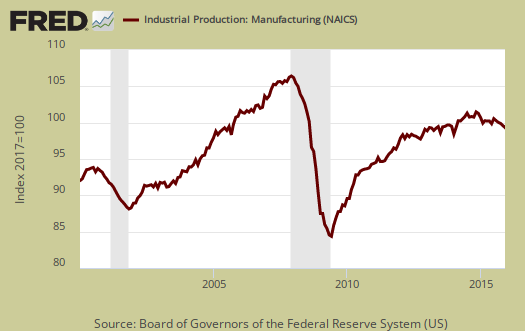
Within manufacturing, durable goods was a wash up 0.1%, with vehicles and parts dropping by -1.7% for the month and up 3.7% for the year. Primary metals dropped by -3.5%. Electrical equipment, appliances and components increased 2.3% while computers increased 1.6%. Machinery dropped by half a percentage point for the month.

Nondurable goods manufacturing declined by -0.2 percentage points for the month. Petroleum and coal products dropped -1.2% for the month while food and beverages increased 0.2%.
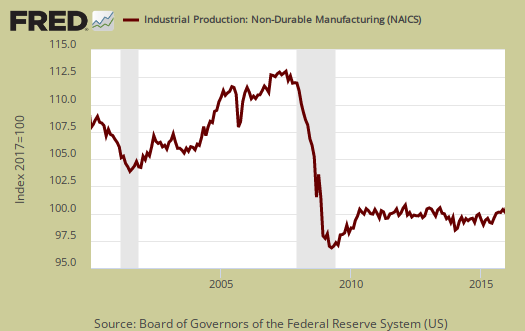
Mining decreased -0.8% and is now down -11.2% for the year. Mining includes gas and electricity production and the Fed have a special aggregate index for oil and gas well drilling. Oil and gas well drilling decreased -7.4% and for the year is down -61.7%. This month the decline was due to coal mining.

Below is oil and gas well drilling and one can see the boom and bust cycle with the amazing downturn now.
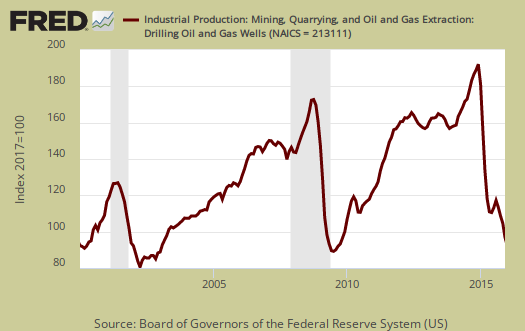
Utilities decreased by -2.0% for the month and is down -6.2% for the year. Utilities are volatile due to weather and why the below graph shows the wild swings. Natural gas declined most for the month of December.
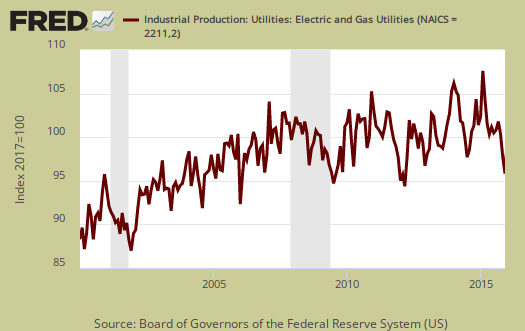
There are two reporting methodologies in the industrial production statistical release, market groups and industry groups. Market groups is output bundled together by market categories, such as business equipment or consumer goods and shown below:
In December, the drop in utilities output contributed substantially to declines in the indexes for consumer goods, business supplies, and materials. The indexes for the major components of those categories unrelated to utilities, however, were little changed or declined slightly: The indexes for consumer durables and consumer non-energy nondurables each declined 0.3 percent, while the indexes for general business supplies and non-energy materials were roughly unchanged. The production of business equipment edged up, as a gain in information processing equipment was mostly offset by decreases elsewhere. The indexes for defense and space equipment and for construction supplies each rose 0.6 percent.
Capacity utilization, or of raw capacity, how much is being used, for total industry is 76.5%, an decrease of -0.4 percentage points from last month. . Capacity utilization has decreased by -2.5 percentage points from a year ago and is 3.6 percentage points below the long run average. This is a pretty horrific trend. Manufacturing capacity utilization decreased by -0.1 percentage points for the month, is 76.0% and is 2.5 percentage points below it's long run average. Within manufacturing, durable goods capacity utilization is 75.8% and is 1.1 percentage points below the long term average Mining capacity utilization is 78.4% and has declined 13.3% from a year ago. Utilities use of it's capacity is 73.2%.
Capacity utilization is how much can we make vs. how much are we currently using, of what capacity is available now, or output rate. Capacity utilization is also called the operating rate. Capacity utilization is industrial production divided by raw capacity.
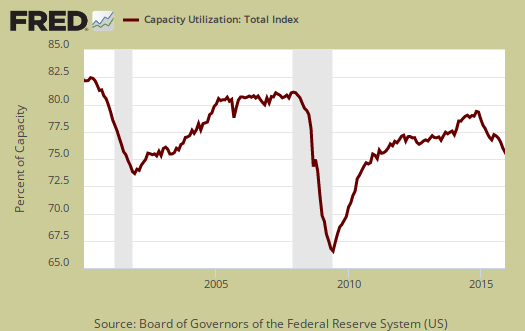
Capacity growth is raw capacity and not to be confused what what is being utilized. Instead, this is the actual growth or potential to produce. Capacity is the overall level of plants, production facilities, and ability to make stuff, that we currently have in the United States. Capacity growth overall has increased 1.5 percentage points from a year ago. Below is the capacity growth increase from a year ago of the subcategories which make up industrial production.
- Manufacturing: +1.2%
- Mining: +3.9%
- Utilities: +0.7%
Below is the Manufacturing capacity utilization graph, normalized to 2007 raw capacity levels, going back to the 1990's. Pay particular attention to the 2001-2003 time frame as manufacturing had a mass exodus to China after passage of the bad trade deal in 2000.

This report is really ominous. One could blame petroleum and coal, yet manufacturing isn't doing so well either. The decline in capacity utilization is a very disconcerting,
Here are our previous overviews, only graphs revised. The Federal Reserve releases detailed tables for more data, metrics not mentioned in this overview.

Recent comments